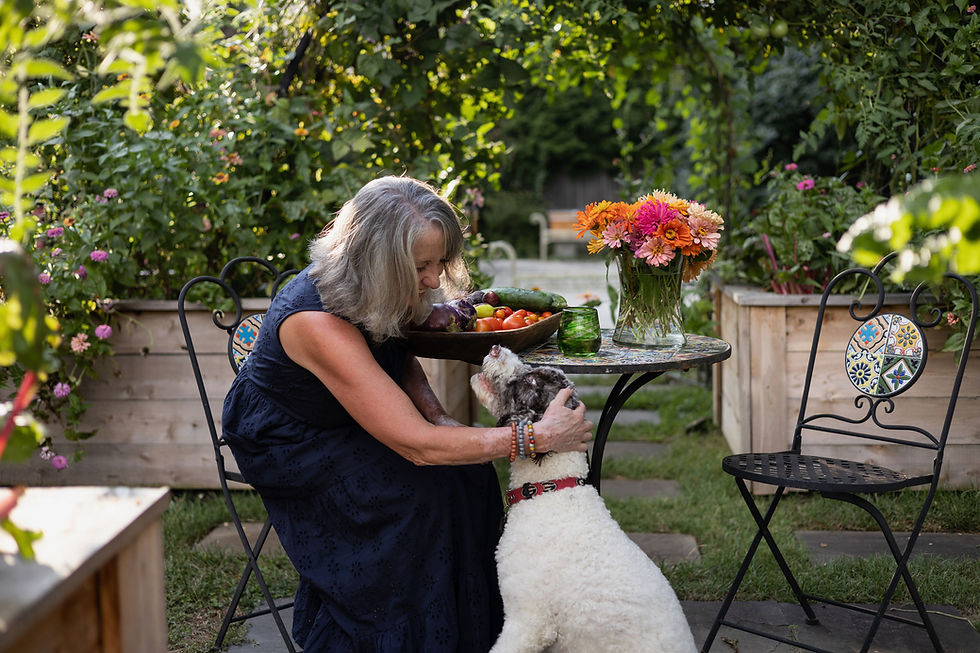North Carolina Gardens: Is It OK to Plant in Summer?
- Sara Rubens

- May 10
- 4 min read
Updated: Jul 2
Funny how the seasons sneak up on us, isn’t it?
One minute you’re brushing leaves off the compost pile—and the next, the sun is high, the soil is warm, and your North Carolina garden is stretching out its arms, ready to grow.
🌿 May is one of those sweet in-between months. Not quite the slow unfurl of early spring, but not yet the full blaze of summer. It’s a gentle invitation to plant with intention, even as the heat begins to settle in.
A question I hear often—especially from newer gardeners—is this:
“Is it OK to plant in summer?”
And the answer? Absolutely yes.With the right timing, plant choices, and a little Southern rhythm, summer planting in North Carolina can be surprisingly abundant.
Let’s take a breath together and walk through what this month offers your garden—no rushing, just gentle guidance. 🍅
🌱 Your May Garden Prep List (North Carolina Edition)
🍅 1. Tuck in your tomatoes
If you’ve been nurturing tomato seedlings indoors or picking them up from a local grower, now’s the time to ease them into their new home.
✅ Soil temps above 60°F? You’re good to go.
✅ Trellises or cages in place? Even better.
Here in North Carolina, our longer growing season means tomatoes can thrive well into the fall—if you give them strong support early and a little mulch to keep the soil cool and tidy.
Think of it as tucking them in with a blanket before the summer heat arrives.

🌿 2. Build your trellises before vines get bossy
Beans, cucumbers, squash—they all have one thing in common: they love to climb.
Getting your trellises in now, before the plants demand it, makes the whole process more peaceful. In our warm and humid North Carolina garden climate, vertical growing can also help improve airflow and keep powdery mildew at bay.
Bonus tip? If you’re in a windy spot or expect summer storms, anchor your trellises a little deeper. It’s one of those “do it now, thank yourself later” moves.
🐞 3. Keep an eye out for early garden visitors (aka pests)
As the weather warms in North Carolina, you might notice aphids and beetles showing up earlier than expected.
Take a gentle peek under leaves and along stems each morning. A simple spritz of water or neem oil often solves the problem—but catching them early makes all the difference.
Ladybugs and other helpful insects are on your side, too. Try planting native flowers to welcome them in. They’re nature’s little garden guardians. 💚
🥬 4. Start a second round with succession planting
If you’ve already harvested early crops like lettuce or radishes, you’re right on time to sow another round.
This practice—called succession planting—is a lovely way to keep your North Carolina garden (and your kitchen) full all season long.
For summer planting, choose crops that love the heat:
Okra
Sweet potatoes
Southern peas
Eggplant
They don’t just survive in Carolina summers—they thrive.
💧 5. Keep watering calm, not chaotic
North Carolina summers can be moody. Rain one day, drought the next.
Your job? Steady, simple watering.
For established plants, I love a morning and mid-afternoon drip schedule—6:00am and 3:00pm works well in my garden.
For seedlings, check often and keep the soil moist but not soggy until roots are well-established.
A little consistency goes a long way.
🌞 So... Is It Really OK to Plant in Summer?
Yes. Unequivocally, gently, joyfully—yes.
A North Carolina summer is not the end of the season. It’s simply the next chapter.
Here’s how to keep growing:
🌶️ Choose heat-loving plants
Think peppers, eggplant, okra, sweet potatoes, Southern peas. These are your summer stars. Let lettuce take a nap until fall—these plants are built for heat.
🌥️ Plant during the cooler hours
Early mornings, cloudy days, or evenings are perfect times to get summer crops into the ground. Transplants appreciate the break from midday sun as they settle in.
🌾 Create some gentle shade
You can use shade cloth, or even plant taller crops to offer natural cover. In Western North Carolina especially, that afternoon sun can be intense—even for sun-loving plants.
🌻 Mulch like it matters
A generous layer of mulch helps retain moisture, reduce weeds, and protect the soil from the full force of summer heat. In our clay-heavy Carolina soils, this step is extra helpful.
🌱 Build your soil, not just your garden
Compost, worm castings, and organic matter work wonders in Carolina red clay. Healthy soil holds moisture better and nourishes your plants deeply—especially important in summer.
Looking Ahead: Your North Carolina Garden Calendar for Summer
Here’s a gentle guide to what you can plant through the coming months:
May: Tomatoes, peppers, eggplant, basil, zinnia, marigolds
June: Okra, sweet potatoes, Southern peas, pumpkins
July: More herbs, sunflowers, cosmos
August: Begin planning for fall—start cool-season seeds indoors
The beauty of our North Carolina garden seasons is that we don’t have to rush. We get a long, lingering chance to grow.
And just when the heat begins to ease, we’ll be stepping into our second spring—fall planting season.
So yes, —it’s more than OK to plant in summer. It might just be your garden’s favorite time of year.
Want my help? Click the button below so you can book a call!




Comments